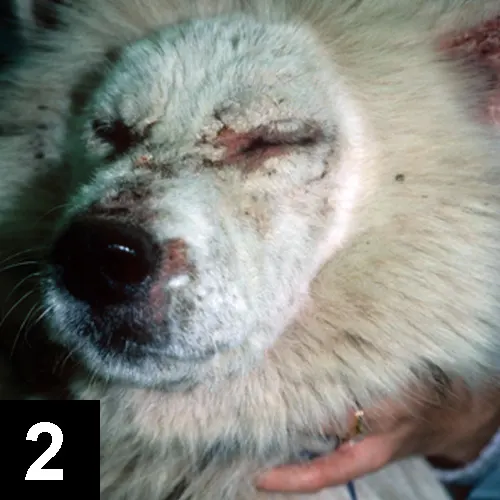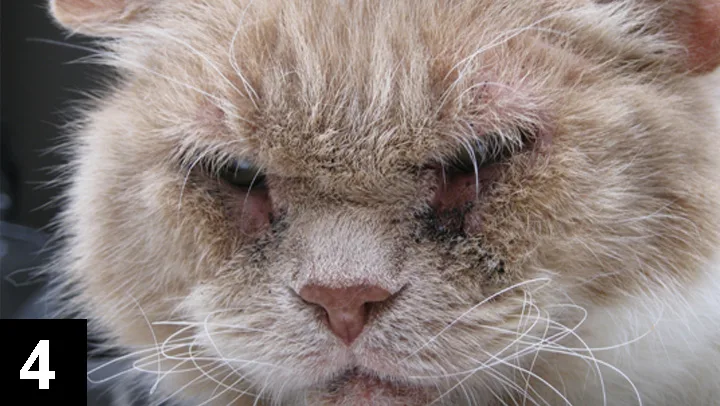Scaling & Crusting Skin Disease
Douglas J. DeBoer, DVM, DACVD, University of Wisconsin–Madison

The skin commonly develops scaling and crusting lesions in response to a variety of inflammatory or metabolic insults.
Some characteristics of these lesions can suggest a specific condition; in other situations, the appearance of the lesions may be nonspecific but clues can be derived from location, distribution, age of onset, breed, presence and degree of pruritus, and any other clinical signs.

Diffuse, delicate scaling on the abdomen of 6-month-old male golden retriever
Congenital Ichthyosis
This disease is an uncommon hereditary and primary cornification defect in golden retrievers. This image shows the characteristic large and delicate “rice paper” scales on the trunk, generally without inflammation or pruritus, that begin at or near birth.

Thick, focal facial crusting in 5-year-old Samoyed
Zinc-Responsive Dermatosis
Though not typically related to dietary deficiency, one syndrome of this disease often afflicts arctic breeds, producing thick-crusted plaques, frequently around the facial area and sometimes around the elbow, hocks, or genitals. Another syndrome of this disease can occur in rapidly growing puppies with zinc-deficient diets. Biopsy will yield definitive diagnosis.

Mild facial pruritus in 5-month-old Domestic Shorthair cat
Dermatophytosis
One classic appearance of dermatophytosis in a young animal is alopecia and fine scaling on the face and forelimbs. However, many other clinical presentations are possible, especially in cats. Conducting a fungal culture is often part of the routine evaluation of feline patients with skin disease.

Facial crusting and severe facial pruritus in 7-year-old cat
Food Allergy
Though food allergy has a variety of appearances, a common presentation in cats is severe pruritus of the head and neck. This case includes inflammation, secondary scaling, and crusting in the periocular region. Note that the ears and bridge of the nose are unaffected (as would be common in facial pemphigus foliaceus).

Greasy scaling and crusting on ventral neck of 2-year-old basset hound
Malassezia (Yeast) Dermatitis
The moist, greasy nature is typical of Malassezia dermatitis, as is the ventral neck location. Basset hounds are especially predisposed to this affliction. Skin cytology is a must for this patient.

Scaling, erythema, and pruritus on ventrum of 13-year-old mixed-breed dog
Epitheliotropic Lymphoma
Though appearances of this disease can vary, the presence of diffused scaling patches and moderate-to-severe erythema is typical. These patients are often remarkably healthy except for their skin. Onset in an older dog with no previous history of skin disease and with no response to treatment is suspicious for this disease: skin biopsy is indicated and will confirm a diagnosis.

Anorexia and difficult mobility in 9-year-old Shetland sheepdog
Superficial Necrolytic Dermatitis (Hepatocutaneous Syndrome)
This syndrome develops in dogs with chronic liver disease or glucagon-secreting pancreatic tumors; thus clinical illness is typical. Metabolic alterations result in crusting ulcerated lesions frequently in the groin area, extremities, and footpads (which may be sore, cracked, or fissured). Clinical appearance can be similar to pemphigus foliaceus: skin biopsy and systemic evaluation are necessary.

Scaling lesions on medial thigh and abdominal area of 5-year-old yellow Labrador retriever
Staphylococcal Pyoderma
This picture shows characteristic coalescing epidermal collarettes, which are the result of ruptured pustules. Note the circular nature of lesions with the ring of scaling surrounding them, along with central erythema and hyperpigmentation.

Severe inflammatory scaling in 11-month-old German shorthaired pointer.
Exfoliative Cutaneous Lupus Erythematosus
This rare breed-specific hereditary disease impacting German shorthaired pointers presents early in life as very severe with whole-body scaling and inflammatory lesions.

Focal inflamed crusting lesions in 3-year-old Pomeranian
Calcinosis Cutis
After receiving multiple injections of a long-acting glucocorticoid, this dog developed the characteristic firm, inflamed, well-circumscribed focal crusts with a raised, sometimes “whitish” appearance on the surface.

Severe pruritus of the pinna in 6-year-old black Labrador retriever
Sarcoptic Mange (Scabies)
This disease typically produces severe pruritus of the ventrum, pinnae, elbows, and hocks. Similar looking itchy and crusted ear margins should always prompt a search for mites—which might be difficult to find—and prospective treatment if mites are not identified.

Facial scaling and crusting in 8-year-old shar-pei crossbreed
Pemphigus Foliaceus
Note prominent crusting and scaling on the bridge of the nose and ears; the presence of depigmentation and ulceration of the nasal planum is a clue that one of the autoimmune diseases is a strong possibility. Biopsy is indicated.

Mild pruritus and marked scaling in 4-year-old cocker spaniel
Primary Seborrhea
Diffuse scaling of the entire trunk area is typical in this predisposed breed. If any secondary infections are present, they should be treated prior to biopsy. Skin biopsy of the scaling area is often helpful in establishing a diagnosis of a primary cornification defect and ruling out other conditions that may have a similar appearance.